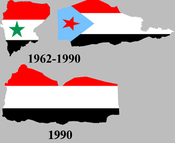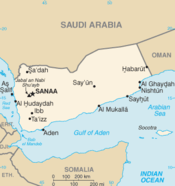[ My teacher was kind of a sap, that explans the ridiculously high mark ]
Yemen is 527,970 square kilometres in area, approximately 9.5% of that land is arable. Yemen has no bodies of water within itself and has 1,906 kilometres of coastline. Yemen rests on the southern tip of the Arabian Peninsula. Its neighbouring countries are Saudi Arabia to the north and Oman to the east. A large part of the border between Yemen and Saudi Arabia has not yet been officially defined. To the west lies the Red Sea and to the south lies the Arabian Sea and the Gulf of Aden. Yemen also includes several islands, the largest being Socotra in the Arabian Sea and Kamaran in the Red Sea.
The total population is estimated at 20,727,063 people with a growth rate of 3.45%. The average population density is about 39 inhabitants/km2. That figure does not tell the truth however, because in western part of the country with the mountainous highlands and significant amount of rainfall, the density can reach up to 300 inhabitants/km"; while in eastern part of the country with its hostile deserts, the density is less than 5 inhabitants/km".
People in the highlands enjoy chewing on "Qat", a plant leaf that provides a suitable high. "The chew" is a daily ritual for the majority of adults in Yemen. People in the lowlands do not chew since the climate is too hot for Qat cultivation. Although Yemen does have oil, it does not have the abundance that is shared by countries in its vicinity. It exports 370,300 barrels of oil a day. Other key components of Yemen's economy are fish, rock salt, marble, small deposits of coal, gold, lead, nickel, copper and agriculture. Yemen has a serious lack of potable water for its people, and...


